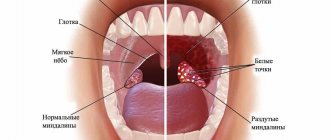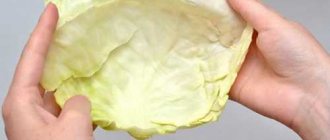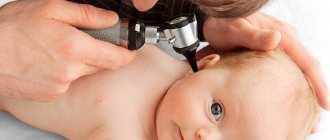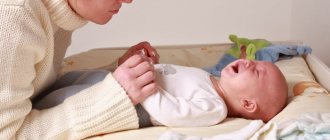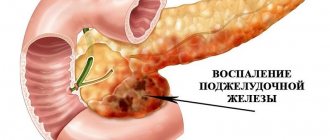Physiological feature of sore throat
Adenovirus leads to significant inflammation
The virus attacks healthy cells and inflammation occurs, which is felt as pain. However, the body acts quickly: the nervous system sends impulses and ordinary inflammation turns into pain, so that a person can react and quickly eradicate the cause.
Inflammation promotes rapid blood circulation, so when you have a sore throat, you feel a rush and burning sensation. Liquid, which under strong pressure comes out of the vessels into the tissue, forms edema.
The entire immune system mobilizes all its forces to eliminate infected cells and create new ones. Adults can clearly identify the type of pain and act immediately; moreover, an adult’s immunity is more stable than a child’s.
The cause of a sore throat in a child can be identified by external signs: the condition of the throat, the presence of elevated temperature, external irritants.
Causes of sore throat:
- Viral pharyngitis is an inflammation of the posterior wall, which is accompanied by dryness and fever.
- Acute tracheitis is swelling and dry cough, which causes a sore throat.
- Acute laryngitis is an inflammation of the larynx associated with an infection that has penetrated the body.
- Sore throat and chronic tonsillitis are acute lesions of the tonsils.
- Inflammation of the lymph nodes associated with hypothermia or tension of the vocal cords.
- Infectious diseases: influenza, ARVI.
- Adenoids - enlargement of the tonsils, which causes an inflammatory process. With adenoids, the child often has his mouth open and can get a cold in the throat in bad weather.
- Sinusitis is an inflammation of the nasal mucosa that blocks the path to normal breathing and transfers all bacteria from the nasopharynx to the pharynx.
- Epiglottitis is an inflammation of the epiglottis, which complicates the airway.
- Scarlet fever - inflammation of the tonsils, rash on the body and in the throat, the presence of plaque.
- Diphtheria - infection of the pharynx.
- Measles.
- Rubella.
Non-infectious causes:
- Loads on the vocal cords.
- Penetration of foreign objects into the pharynx.
- Throat injuries - mechanical damage.
- Burn.
- Irritation associated with dust and lint getting into the throat.
- Allergic components.
- Problems with the gastrointestinal tract.
- Vitamin deficiency.
- Problems with the spine.
How to treat a child's red throat? baby's throat is very red
A red throat in a child is a common symptom that can indicate the onset of diseases such as acute respiratory viral infections, acute respiratory infections, tonsillitis, pharyngitis, and laryngitis. In order for treatment to be effective and not drag on for an indefinite period of time, it must be started as quickly as possible.
Red throat is a symptom of various diseases
First you need to show the patient to a pediatrician. The doctor will examine your throat and tell you what is causing the redness. Most often this is:
- exposure to irritating factors;
- allergies to certain chemicals, foods;
- viral or bacterial infection.
Also, a child may experience a red throat during the eruption of baby teeth, due to general hypothermia of the body. Each case has its own treatment. Sometimes there is no need for it at all.
Types of sore throat
With sore throat, which is an infectious-allergic disease, the sore throat has an acute pain, the back wall is usually fiery red with pimples, with chronic or prolonged sore throat, abscesses and ulcers appear.
Such a disease can be provoked in a child by weakened immunity, contact with sick people, and simple hypothermia. With repeated tonsillitis, measles and scarlet fever may develop.
Pharyngitis in its pure form rarely appears; it usually starts with a cough, and it causes soreness, resulting in an inflammatory process in the throat. If you suffer such a disease on your legs, it can cause more serious problems, your kidneys and heart may suffer.
Read: What are the dangers of white pimples on a newborn?
Laryngitis manifests itself as a dry cough and shortness of breath, which later develops into a wet cough and chest pain.
Adenoids are a common problem for children aged three years and older: heavy breathing and an open mouth can cause not only infectious diseases, but also an accompanying cough. A prolonged runny nose becomes purulent, descends into the lungs and leads to a wet cough with chest pain.
Comments (11)
Elena
03/15/2019 at 10:39 |
Until adolescence, my daughter often had colds that progressed to laryngitis, pharyngitis, and bronchitis. We were always treated as prescribed by the doctor and added traditional medicine, plus inhalations.Answer
Expert Marina Rusetskaya
03/16/2019 at 22:57 |
Elena, they did the right thing in taking a comprehensive approach to treatment. But different age periods have their own peculiarities in the treatment of sore throat in children.
Let's figure it out.
Infants cannot have contact as babies are older. The baby will not gargle, suck on lozenges and lollipops, and will not allow the aerosol to splash. In addition, a number of drugs are contraindicated for infants.
Treatment for a sore throat in a child includes:
1. Mandatory breastfeeding and the more often the better (if the mother has milk). If the baby is bottle-fed, you can divide his portions of the formula into several smaller ones. 2. Install a humidifier in the children's room. Maintain humidity at least 50%. 3. Try to give warm drinks (water, compote), at least a sip. 4. Do not walk with your child on the street.
Children from 2-3 years old can be given warm milk with honey to drink (provided that there is no individual allergic reaction), use an aerosol, give lozenges with essential oils to dissolve, or do inhalations.
Children from 4 to 5 years old understand how to gargle and can gargle. Plus the rest of the comprehensive treatment.
An air humidifier should always be in the house and working, especially during the heating season. Since drying out the mucous membrane provokes inflammation and pain.
In addition, streptococcal flora is the causative agent of infectious diseases in preschool children. Therefore, you can discuss with your pediatrician the need to be vaccinated with the Synflorix vaccine.
An effective method for preventing inflammatory diseases of the respiratory system is trips to the warm sea for a period of 18 days.
You can replace a trip to the coast with a treatment course in salt caves.
Answer
Nika
03/25/2019 at 23:48 |
Children often have tonsillitis, I think in this case there is no point in tormenting the child and regularly washing the tonsils, it is easier to remove them. Because it is much more difficult for an adult to remove them, since all the organs are already formed.
Answer
Expert Marina Rusetskaya
03/27/2019 at 22:09 |
Nika, you are partly right, partly wrong.
The question of removing pharyngeal tonsils should be decided by a doctor based on the frequency and severity of the child’s illnesses.
The fact is that tonsils or tonsils are a collection of lymphatic tissue that ensures the normal functioning of the immune system.
If we start performing tonsillectomies on everyone, the incidence of ARVI and similar diseases will increase sharply. By the way, a similar experiment was carried out several decades ago in the West with the appendix (a vermiform appendix that is located on the dome of the cecum).
Patients had the appendix removed prophylactically so that it would not become inflamed, and people would not suffer from appendicitis. As a result, the incidence of respiratory infections has increased.
On the other hand, if a child experiences tonsillitis many times a year (5 or more), it is really necessary to discuss with the attending physician the need for surgical treatment.
A trip to the warm sea in the summer for at least 18 days will help strengthen your baby’s immunity. The sea can be replaced by visits to salt caves, a course of 10 sessions.
And lastly, it doesn’t matter when the organ is removed (in adulthood or in childhood), surgery is surgery. Each period has complications and risks, and the immune system works until the death of the body.
Therefore, removal of the tonsil will affect the patient, large or small, in any case.
Answer
Nika
04/04/2019 at 09:48 |
It seemed to me that children tolerate this operation easier than adults. It will be easier for them to recover than for us. It turns out I'm completely wrong? A friend told me how normally she underwent surgery as a child compared to the older girls in the ward.
Answer
Lilya
05/25/2019 at 05:33 |
I suffer from pharyngitis and the plugs in my tonsils have already been washed out. I will say that if possible, a trip to the sea has a beneficial effect; this year I had traffic jams, but still not as often as before. What can replace the sea?
Answer
Expert Marina Rusetskaya
05.25.2019 at 23:32 |
Lilya, if you can’t go to the sea, go to the salt caves.
Most often, the course of treatment is 10 days. During the session, the patient is in a room with salt walls and floor, and through a special device, crushed salt is supplied into the room, which saturates the air.
The session lasts about 1 hour, the effect is similar to a trip to the sea.
In women, many chronic diseases (including tonsil plugs) go away during pregnancy.
Physiologically, while a woman is carrying a child, her hormonal levels change, which helps to cure certain diseases.
Answer
Lydia
09.15.2019 at 16:40 |
My daughter rarely had a sore throat in early childhood. They were treated mainly with lollipops and lozenges for sore throats, and drank an antibiotic-based suspension. Later, when she learned to gargle, furacillin came to the rescue.
Answer
Marina
09.28.2019 at 20:18 |
Useful article. We have tried many remedies for a sore throat. Lizobakt helps best; it clearly does not mask the pain, but treats exactly its cause.
Answer
Alina
12/12/2019 at 08:01 |
The most important thing after recovery has occurred is to build up your immunity so that you don’t catch anything like this again for as long as possible. After the illness, we started giving immunovitamins and teas with raspberries and sea buckthorn. It helped a lot, I want to say. We managed to live through the entire fall without coughing or snot))
Answer
Marina
02/10/2020 at 18:20 |
Lizobact for resorption helps us, we took it as prescribed by the doctor. It fights infections well and prevents getting sicker. It has a natural composition and is suitable for children from 3 years old.
Answer
Sore throat with fever in a child
A sore throat, which is accompanied by a fever, immediately indicates an infectious disease. The child’s normal condition is around 35.6–36.9 degrees; if the temperature rises, this indicates the occurrence of respiratory ailments.
If the temperature exceeds 39 degrees, antipyretic and medical intervention is necessary.
If the temperature is combined with a cough and:
- Unbearable pain in the throat.
- When inhaling and exhaling, a whistling noise is heard in the lungs.
- Sore throat and sore throat.
In such cases, it is necessary to consult a doctor or call an ambulance, because the combination of fever and cough can be pneumonia or pneumonia, which are very dangerous for children.
However, fever and sore throat can be a common respiratory infection and can be treated with antipyretics, drinking plenty of fluids, and rinsing the mouth.
Parents should take note! Do not self-medicate; the child must be shown to a pediatrician who can determine the source of the disease, use medications to lower the temperature and relieve nasopharyngeal inflammation.
Sprays for irrigating a child's throat
You can use antiseptic rinses. It is recommended to use painkillers, antimicrobial, anti-inflammatory drugs.
Tantum Verde is popular; it can be used to stop the inflammatory process, relieve a child of pain, and destroy pathogenic microflora. It is used as a spray for children from 3 years old.
We suggest you read: How to remove a baby tooth at home
Some pediatricians prescribe it from six months, remember that this is dangerous, it may cause spasm of the larynx. You can spray it not in the throat, but on the cheeks; the child himself will smear it on the throat with his tongue.
Miramistin is popular, it is sold in bottles, the liquid has no taste or smell, relieves inflammation, and actively fights viruses. It can be used to cure various diseases of the oral cavity. It is safe for children; it is administered with a syringe without a needle.
From 3 years old you can use anti-inflammatory, antimicrobial sprays - Hexoral, Ingalipt, Bioparox. Monitor your child's reactions to avoid a serious allergic reaction.
What to do if the temperature does not subside
It is not always possible to see a doctor right away. Then the question arises: whether to act immediately, whether to bring down the temperature. There are many weak and strong antipyretics: Ibuprofen, Analgin with Demerol, Paracetamol.
However, temperature is the body’s fight against foreign bacteria. Moreover, the body produces antibodies to fight such viruses. Regular rubbing with vinegar and drinking plenty of fluids can reduce the temperature.
But it’s better to look at the child’s well-being: if the body copes on its own, then you shouldn’t get ahead of it by other means.
Sore throat and antibiotics
Many caring parents, wanting to help their children, give antibiotics on the 4th–5th day of illness, if there are no visible changes.
Therefore, there is a misconception that antibiotics cure all diseases, especially those that last a long time.
However, such medications have an antibacterial effect, that is, they fight bacteria. And if viruses are present in the body, then any antibiotic is powerless.
Therefore, first of all, it is necessary to find out the source of the disease in the child, and treat accordingly.
Read: Abdominal pain in newborns
Types of antibiotics for treating throat
When treating a sore throat that is affected by a bacterial infection, several types of antibiotics are usually prescribed:
- Cephalosporins – have an inhibitory effect, stop the development of microorganisms.
- Penicillins are a disinfectant and bactericide.
- Fluoroquinalone is a group of antibiotics for restoring the respiratory tract.
- Macrolides help to get to the heart of the problem and eradicate all the potential for new bacteria.
Such antibiotics are available in tablets or small granules, which makes them convenient for use by children.
Rules for taking antibiotics for a sore throat
First of all, all antibiotic use must be agreed upon with a pediatrician. The first dose of medication is very important: it helps to determine the presence of adverse or allergic reactions in the body and will show its strength.
Secondly, it is necessary to follow all dosage recommendations and proportions. Exclude dairy products from the child’s diet for the time being and take medications with bacterial additives.
Such drugs help restore balance in the intestines and prevent the development of thrush.
Pharyngitis
With pharyngitis, the wall of the pharynx becomes inflamed. This disease can develop either independently or as part of other diseases. It is caused by an infection that is absorbed by the mucous membrane of the pharynx. Most often it gets there by air, but you won’t be able to not breathe so as not to get infected. Therefore, first of all, you need to pay attention to your habits and lifestyle.
To prevent the development of pharyngitis, it is not advisable for a child (and an adult) to do the following things.
- Supercool. Although hypothermia itself does not lead to inflammation, however, it reduces the body’s defenses, opening access to harmful elements.
- Drink or eat too hot or cold, or too spicy food. Even a harmless love of hot tea can lead to micro-wounds on the surface of the mucous membrane, through which it will be very easy for infection to penetrate inside.
- Smoking. Tissues that constantly absorb nicotine tar are more vulnerable to infections.
- Do not treat diseases of the stomach and esophagus. Such diseases are unpleasant in themselves, but they also endanger neighboring organs. - bile and infection spread to all surrounding organs, including the pharynx.
You may be interested in: Sore throat: causes, symptoms, treatment
It is not difficult to understand that you have become infected with pharyngitis.
- Your throat hurts. It hurts you both to eat and drink, and just to swallow saliva. Many people describe their sensations as “like I’m swallowing blades.”
- Tickle in the throat. You constantly drink water or suck on lozenges, because without them your throat seems to dry out. A lump in the throat and a scratching sensation also indicate pharyngitis.
- You clear your throat to clear the blockage in your throat. You feel like you've inhaled a feather and now you can't swallow it or reach it.
Other noticeable signs of pharyngitis are as follows.
- Redness of the throat. Moreover, the entire throat and all its components immediately turn red. Children have red dots on the walls of the palate.
- The walls look grainy. Upon examination, you will notice that the follicles have enlarged due to infection and began to resemble grains. In a difficult case, they will take on not only the infection, but also pus, and pharyngitis will turn into a purulent follicular form.
- Plaque on the walls. It indicates the entry of bacteria into the throat, and the transformation of pharyngitis into purulent fibrous.
All these symptoms can be described and detected by an adult, but not by a child. However, it is important that the parent has a good understanding of the nature of the pain and is able to identify it by the restless behavior of the baby. All of them, together with fever, lethargy and especially refusal to eat, are a serious reason to visit a doctor.
We suggest you familiarize yourself with Bad breath from the stomach: causes and how to get rid of it
Pharyngitis, as a rule, is viral in nature. This means you shouldn’t take antibacterial medicine (antibiotics) right away.
If pharyngitis has not entered the purulent or chronic stage, but develops along with a cold or ARVI, then it usually goes away in 4-5 days. If the disease progresses, you may see a very red throat in the child.
The doctor determines what to treat by choosing appropriate antiviral agents and concomitant therapy. It is important to follow a number of rules that will help the child recover faster.
- Do not eat or drink hot foods. Eliminate dry and scratchy foods from your diet. Let everything you eat or give to your baby be warm and soft.
- Introduce foods with vitamins C, E and A into your diet, or simply take the appropriate vitamins.
- Drink a lot - the best thing is tea with lemon, brewed compotes or fruit drinks.
- Take care of air humidity. If you don’t have a special device, then it will be enough to spray the curtains in the room with a spray bottle several times a day. When drying, they will release moisture into the room.
You may be interested in: Sore throat during pregnancy: treatment methods
To relieve pain, you can gargle with saline solution. Essentially, saline solution is lightly salted water (half a teaspoon per glass of water). If you add 3 drops of iodine to the rinse, the salt water will taste better and the solution will be healthier for the body.
You can resort to folk remedies and gargle with infusions of sage, chamomile or eucalyptus. They are easy to buy at any pharmacy. Recently, herbs have been packaged in tea bags, which are poured with boiling water. After the collection has been left for a few minutes, the rinse will be ready.
Of the ready-made mixtures of throat medications you can buy at the pharmacy:
- sprays and aerosols “Kameton”, “Ingalipt”, “Yoks”, “Stopangin”;
- lozenges “Antiangin”, “Sebilin”, “Faringosept”, “Imudon”, “Strepsils”;
- ready-made solutions “Rotokan”, “Octenisept”, “Miramistin”, “Povidone-iodine”;
- effective products with sulfonamides and antibiotics: “Grammidin”, “Stopangin”, “Bioparox”. They are usually prescribed by a doctor if more serious treatment is needed.
If antiviral drugs do not work, the disease may be bacterial in nature, and therefore you need to take antibiotics.
But antibiotics fight all bacteria, even those that live in the throat and are necessary for the normal functioning of the body. By killing harmful bacteria, antibiotics also destroy beneficial microflora.
Therefore, these drugs can only be taken after a doctor’s prescription, if he determines that the causative agent of the disease is bacteria.
Do not choose antibiotics for self-medication when deciding how to treat your throat. For a child 4 years old and younger, especially an infant, these drugs can cause more harm than good, and at an older age they may simply be useless.
Dr. Komarov's advice: antibiotics for sore throat
One of Komarov’s main pieces of advice is that “if an antibiotic is not indicated, then it is contraindicated. Moreover, it is a serious medicine and is taken as prescribed by a doctor.”
In frequent cases, a sore throat in children is a viral infection and cannot be treated with any antibiotics.
Children's sore throat
However, in all cases, the root cause of the disease is sought. For example, childhood sore throat is caused by staphylococci and streptococci, to which different antibiotics are used. Parents need to remember that there are 2 types of antibiotics that fight sore throats in children.
In the first case, if the child does not improve within 12 hours after taking antibiotics, then this antibiotic is bacteriostatic. It stops the proliferation of new bacteria, but inflammation and sore throat do not go away, because the body itself fights the remaining bacteria.
Otherwise, a bactericidal antibiotic kills all bacteria and a quick improvement occurs, pain and swelling from the throat will be relieved.
Treatment with drugs
Therapy using medications should be carried out under the supervision of a physician. Only in this case will it be possible to achieve the desired result and not cause harm to the child’s body.
Types of children's throat medications
Throat diseases in children can be treated using various means; pediatricians prefer:
| Sprays: | Lollipops: | Solutions for rinsing: |
| Depending on age, you can use various drugs in the form of a spray; the following are effective: Ingalipt, Hexoral, Cameton. | A common form that is preferred when treating children over 6 years of age, since it is believed that from this age the child can independently dissolve the lozenge without choking on it. Most often, when prescribing treatment, the following are prescribed: Adjisept, Lizobakt, Grammidin for children, Faringosept. | You can use Chlorhexidine in solution, Miramistin. Furacilin is a good choice; dissolving the tablets in water, you will get an antiseptic drug suitable for rinsing. |
Treatment of sore throat with folk remedies
Nature has never yielded to drug treatment in the healing spheres. Various herbs and decoctions for rinsing will help get rid of pain and relieve inflammation in a short time, even in a child.
Dairy products not only help fight acute sore throats, but also help fight the source of pain - coughing.
Dissolve a tablespoon of honey in a glass of warm milk and drink in small sips. Sweet milk is just right for children, and while drinking milk will bring pleasure, it will also bring benefits.
If you experience periodic attacks of coughing and choking, which are caused by a sore throat, goat fat will help. The taste is not pleasant, but it can be brightened up by adding it to tea or taking it with honey. Goat fat stops coughing and soothes the mucous membrane of the throat.
Read: How and when is ultrasound of the hip joints necessary in newborns?
For rinsing, herbs and bee products are good options. Propolis diluted with water has an anti-inflammatory effect.
Diagnosis of the disease
It is carried out in stages and involves several procedures; in order to obtain reliable information about the condition of a small patient, the doctor will need:
- conduct a visual examination of the throat;
- collect material from the nasopharynx for laboratory testing;
- donate blood and urine for general and biochemical analysis.
The doctor will weigh the child, listen to his lungs, and, if necessary, prescribe other diagnostic procedures.
In most cases, it is enough to conduct a visual examination of the nasopharynx using a spatula - this will help to understand what is bothering the baby and how pronounced the symptoms are.
Gargling and tinctures for sore throat
Sage, tincture of chlorophyllipt, calendula, chamomile are poured with boiling water and infused for half an hour. Rinsing should be done every half hour. Herbs help eliminate soreness and temporarily relieve pain. If the child is quite old, he can rinse himself. If it is small, then homemade herbal tinctures are used and given as syrup.
The basis for such tinctures is water-alcohol syrup. The tincture takes place in two stages:
- Stage 1 Grinding of raw materials and infusion with alcohol.
- Stage 2 Strain the syrup, pour in new alcohol.
Fresh crushed raw materials are infused in alcohol for no more than two days.
As for steam baths for sore throats, it is not recommended. After all, a relapse or side effect may occur.
Steam baths for sore throat
Furacilin helps get rid of the consequences of purulent sore throat. Furacilin tablets are crushed and filled with water. This rinse will help relieve the inflammatory process from the tonsils, remove plaque, and get rid of ulcers.
Honey has medicinal properties in nature and helps in treating bacterial diseases. Children will especially like it, because it even tastes very tasty.
The tandem of honey and chamomile helps get rid of a sore throat. You need to brew chamomile, cool it, and add a little honey. Use 5-7 times during the day.
An effective gargle against a sore throat in a child is beetroot juice. Freshly squeezed juice contains healthy and organic elements. But it must be diluted with cooled water and rinsed until the pain disappears.
The best and most proven remedies for sore throats are salt, soda, and iodine. Baking soda acts like an anesthetic and relieves pain. Salt disinfects throat lacunae and relieves swelling.
You can prepare the solution like this: add a tablespoon of salt and a few drops of iodine to a glass of warm water or mix salt and soda in equal proportions. Rinse 4-5 times a day.
The root of Icelandic moss has an immunomodulatory, anti-inflammatory, and antibacterial effect. The dried plant must be brought to a boil and strained, taken three times a day, 2 teaspoons. Despite the interesting name, Icelandic moss is available for sale in all pharmacies at a reasonable price.
Marshmallow root has a softening effect and reduces inflammation. Helps get rid of cough and swelling of the throat in a child.
Treatment of throat at home in children
If a child has pain in the larynx, you should not delay treatment.
In this case, not only medications are used: therapy, along with the use of systemic and symptomatic drugs, requires the implementation of measures to normalize the humidity and temperature conditions in the children's room. In addition, the patient is prescribed bed rest and active consumption of warm liquids. To quickly cure a child’s throat, you need to:
- set the room humidity at 50-70%;
- adjust the room temperature to 19-20 degrees;
- feed the patient light, soft, moderately warm food;
- Give your baby warm drinks more often - teas, herbal decoctions, fruit drinks, compotes.
Advice from Dr. Komarov
- Provide the child with peace and less active games.
- Humidity and air temperature in the apartment (within 20 degrees, about 50% humidity).
- Drink plenty of fluids (warm liquid).
- The best natural remedy for a sore throat is cocoa-flavored faringosept; these tablets will help relieve swelling and eliminate pain.
- However, if you experience nausea, headaches, or skin rashes, you should immediately consult a doctor.
You can be treated at home or you need to run to the hospital in the following video:
17 Mar 2021 Valeria 338
Share this post
We recommend reading along with this article
- How to cure chronic tonsillitis in a child, what remedies...
- How to relieve your child's cough at night on your own
- Should parents worry if their child starts coughing?
- Symptoms and treatment of pharyngitis in children
- Symptoms and treatment of false croup in children
- Dry cough in a child without fever: causes and treatment
- Features of treatment of tracheitis in children
- Treatment of tonsillitis during pregnancy: whim or necessity
- Homeopathic nasal drops for children - proven and effective
Discussion: 4 comments
- Natasha:
03/18/2018 at 00:13I really like Decatylene sucking tablets, they are better than Strepsils, if the child is not an infant, then they are quite suitable for his treatment, at the initial stage of the disease, they are simply not replaceable.
Answer
- Rita:
07/20/2018 at 15:47
When my baby started to have a sore throat, we tried many different tablets and lozenges until our doctor prescribed Lizobact tablets, they treat the throat for various infections. These tablets helped us great.
Answer
- Nastena:
10/22/2018 at 02:53
I like rinsing with chlorophyllipt, but the product should be alcohol-based, add a teaspoon to a glass of warm water and you can start treatment. For colds we cannot replace it.
Answer
- Valya:
04/28/2019 at 00:17
You can buy some kind of throat spray, I liked Hepilor, but it only helps for 3-4 hours; in my opinion, this product alone is not enough for a complete recovery.
Answer
Gargles and lubricants
You can gargle with any antiseptic; some prefer a solution of potassium permanganate or hydrogen peroxide. But it is not advisable to use such drugs in children.
It is better to give preference to Chlorhexidine, Sea water, Saline solution.
Lubricate the throat with Lugol - this is iodine, which has a powerful antiseptic effect. Blue iodine is also used in pediatrics, but in our country it is rarely used.
You can rinse with Chlorophyllipt, an extract from eucalyptus leaves.



